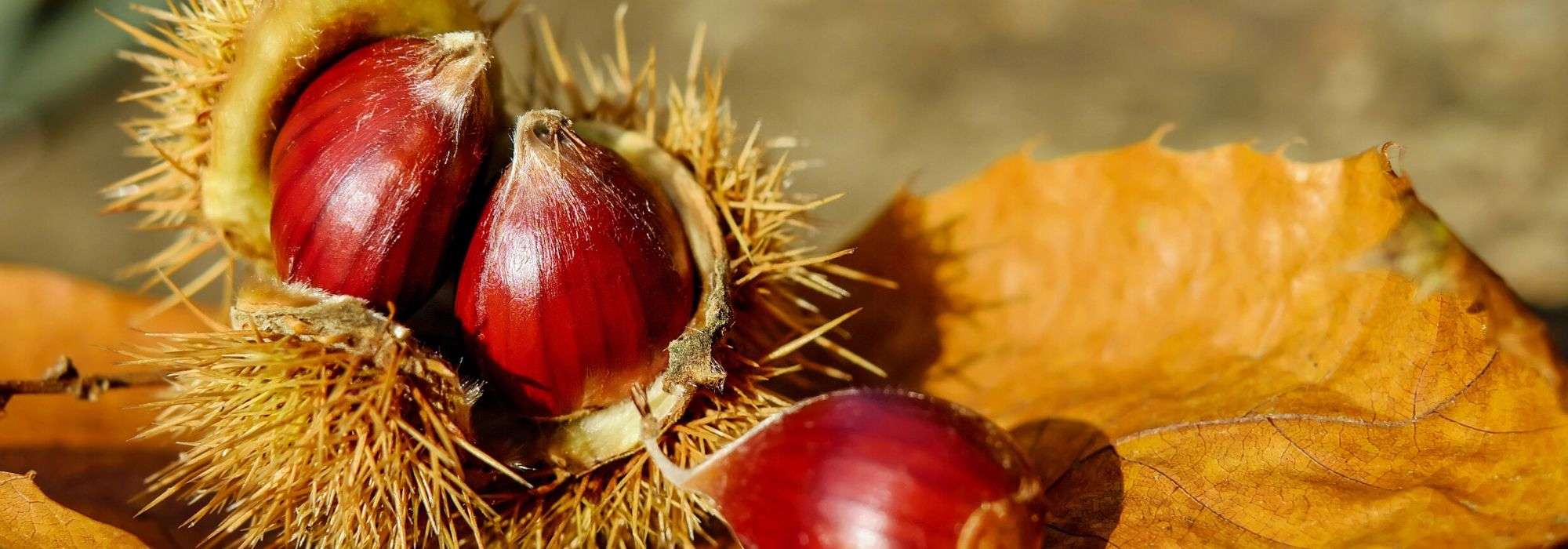
Chestnut tree: planting, pruning and care
Contents
Chestnut, in a nutshell
- Chestnut tree is a fruit tree known for its chestnuts, sometimes called marrons, eaten in autumn and winter.
- It forms a handsome, fairly hardy tree with large dentate leaves that grows only on acidic soil.
- Flowering with a honeyed scent attracts many foraging insects and produces a renowned honey.
A word from our expert
Chestnut tree is a vigorous tree native to Mediterranean countries, the Black Sea and Caspian Sea regions and prefers southern France where vines grow because it needs warmth for its fruits to reach ripeness. Its main requirement is to grow in acidic soil with a pH between 5 and 6.5 because it cannot tolerate calcareous soil, and it benefits from deep soil, even poor, that stays sufficiently cool in winter and spring. Its long, toothed, intensely green leaves with parallel veins are easily recognisable and are sometimes used to wrap cheese to aid preservation. Chestnut forests dress in wonderful golden colours in autumn when chestnuts drop to the ground surrounded by their burrs barely opened.
Chestnut makes a very fine shade tree, with a pyramidal habit in youth becoming massive with age, reaching 15 to 25–30 m high and 8 to 12 m wide. Cultivation requires a lot of space but needs no particular maintenance while rewarding you with delicious chestnuts to roast or to boil in water. Its flesh is used to make the famous chestnut cream and also as a very nutritious flour. Well peeled and boiled chestnuts are an essential ingredient of the famous turkey with chestnuts. Chestnut is part of shell fruits reputed for their medicinal virtues, notably in combating heart attacks and strokes. The tree is also prized for its longevity and for the quality of its wood.
Do not confuse chestnut fruit with that of the horse chestnut, which is toxic! Horse chestnut has compound leaves that divide like the fingers of a hand and are attached to a long petiole. The burrs surrounding the round conkers are much less spiny than those of the chestnut, which has a broad base and a pointed tip. The name “marron glacé” used in confectionery applies to chestnuts that show a large single almond when shelled.
Description and botany
Botanical data
- Latin name Castanea sativa
- Family Fagaceae
- Common name Chestnut
- Flowering June to July
- Height between 15 and 30 m
- Exposure sun or partial shade
- Soil type sandy, deep, acidic soil
- Hardiness Good (-15 °C)
Common chestnut belongs to family Fagaceae, like beech or oak.
Its Latin name Castanea sativa comes from Greek kastanon, name given to Greek town of Castane, famed for its chestnuts in Antiquity, while among Romans word Castanea referred to oak. Genus comprises 12 species of trees and bushes of temperate regions of North America, China and Japan. Species sativa, indicating cultivated species, originates from shores of Mediterranean, Black and Caspian Seas where it grows among other deciduous essences. Chestnut has been cultivated in China for at least 5,000 years and cultivation spread to West thanks to Romans. It is mainly found on poor terrains completely free of limestone, in upland areas up to 1,200 m altitude as in Cévennes or Limousin.
Chestnut forms a tree with pyramidal habit that broadens with age, typically reaching 15 m height and 8 m girth but capable of topping 30 m in good conditions. Chestnut is very hardy, able to live for several centuries (over 2,000 years). Young bark is smooth silver-brown, darkens and fissures forming characteristic spirals around the trunk counter-clockwise. Tree develops both a deep taproot and spreading roots.
Leaves of chestnut are alternate and deciduous. Carried on a short petiole, they have an elongated shape with serrated margins, easily recognisable. They can reach 25 cm long and 4–8 cm wide. Lamina is glossy dark green above and duller beneath and turns golden yellow in autumn before browning and falling.
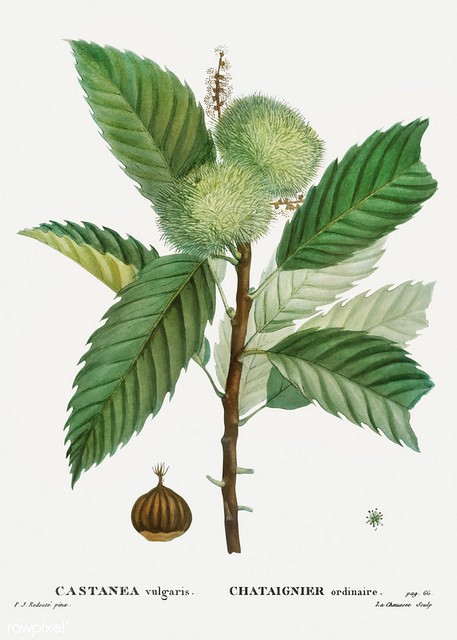
Castanea sativa – botanical illustration by P.J. Redouté
Flowering appears in June–July on current-year shoots, as male aments 15–25 cm long, very fragrant with honey scent, attracting many pollinating insects. Female flowers, yellow-green and much less conspicuous, placed at base of male aments, reach ripeness slightly before male aments open. Some cultivars such as Marron de Lyon can be self-fertile so chestnuts can be harvested from a single tree. However, to increase yield it is advisable to plant several trees including wild types to encourage cross-pollination, which is effected by wind or insects. Others such as ‘Bouche de Bétizac’ are totally sterile due to absence of stamens on the tree.
Unlike conkers, which are seeds of horse-chestnut, chestnuts are true fruits of the chestnut in botanical sense as they bear remains of pistil at the tip. They are achenes, i.e. dry indehiscent fruits with a single seed whose shell can be easily detached. These fruits are contained in a very spiny burr which detaches from the shoot at maturity in September–October and splits down the middle. Cultivated varieties present 1–2 large fruits per burr while wild chestnuts contain 3–4 small, rather flat chestnuts. Note, term «marron», as in “marrons glacés”, also designates a type of chestnut prized in confectionery that produces a single almond not partitioned by the dissepiment called tan. True conkers from horse‑chestnut (Aesculus hippocastanum) are not edible! Chestnut can be eaten roasted over embers, boiled, or made into sweet purée after removing bitter membrane, the tan, that envelopes the seed.
Chestnut fruits long earned name “bread of poor”, with their ground flesh used as a nourishing flour, twice as calorific as potato. This tree, able to establish on poor acidic, sloping ground, was often main food source in upland areas such as Cévennes. Today chestnut flour has become a luxury product!
Rot-proof chestnut wood is valued for building frameworks, half-timbering, tiles of Mont St Michel, furniture… It also has reputation for repelling spiders like conkers.

Chestnut: flowers, leaves and fruits
Read also
Oaks: planting, pruning and careMain chestnut varieties
Variety suited to south-west and Brittany
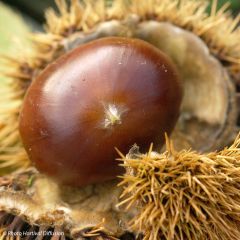
Chestnut Marigoule - Castanea sativa
- Flowering time July, August
- Height at maturity 15 m
Variety suited to Rhône Valley
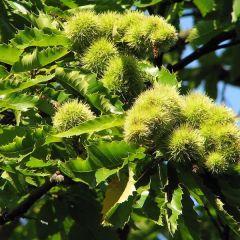
Chestnut Marron de Lyon - Castanea sativa
- Flowering time July, August
- Height at maturity 15 m
Discover other Chestnut trees
View all →Available in 1 sizes
Available in 1 sizes
Available in 2 sizes
Available in 1 sizes
Available in 1 sizes
Available in 1 sizes
Available in 1 sizes
Available in 1 sizes
Planting
Where to plant sweet chestnut?
Choose varieties according to your region because some varieties demand more heat than others: average temperatures of 19–20 °C in July–August versus 10–20 °C; others, such as Marigoule, are sensitive to late spring frosts. Vine-growing regions are generally suitable for growing sweet chestnut provided they receive rainfall from September. Minimum of 700–800 mm rainfall required annually. Sunny slopes in mid-mountain areas are also suitable.
Sweet chestnut tolerates very little lime and requires a pH between 5 and 6.5. Provide deep, rather sandy soil, well drained and preferably fertile even though the species is not demanding. Provide a sunny to semi-shaded position.
When to plant sweet chestnut?
Plant sweet chestnut in autumn–winter, outside frost periods, or in spring.
How to plant sweet chestnut?
- Immerse pot in a bucket of water to thoroughly moisten it.
- Space trees 8–10 m apart if planting several.
- Work soil to a depth of 30 cm then dig a wide hole.
- Add a few shovelfuls of coarse sand if soil is clayey, a basal fertiliser and organic manure such as well-rotted compost or farmyard manure.
- Install a stake on side exposed to prevailing winds.
- Backfill hole without burying the collar, forming a basin and firming lightly.
- Tie trunk to stake with a soft tie.
- Water generously and mulch.
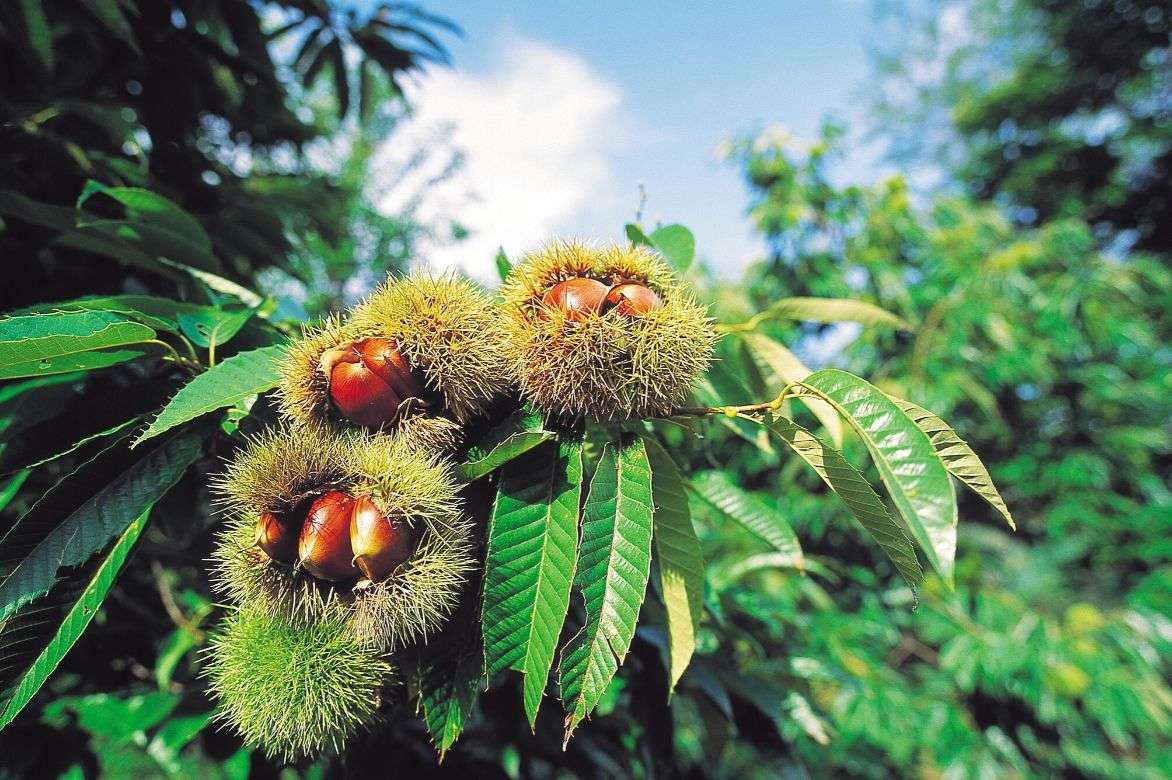
Sweet chestnut care and pruning
- To encourage the development of next year’s flowers, ensure soil remains cool towards the end of July.
- Pruning of the chestnut can be carried out in winter or in summer, preferably in two stages :
- In June, shorten shoots by a few centimetres to slow their growth.
- In August, check the tree’s overall shape and remove low branches arising from the trunk if necessary, and keep a single leading shoot if the trunk has forked.
- When the tree starts to produce fruit, after 4–5 years, consider removing the weakest branches to encourage light penetration.
Diseases and pests of chestnut
Chestnut is generally a robust tree, very easy to grow in the garden. There are however some serious conditions such as the canker of the chestnut, a disease caused by a fungus that causes reddish swellings of the bark and can also attack oaks or maples. Heavy but effective organic treatments consist of introducing an attenuated strain of the fungus by drilling holes around the cankered area. Ink disease (Phytophthora cambivora) sometimes appears on poorly drained ground, causing wilting of shoots followed by death of the tree, associated with the oozing of a blackish liquid at the base of the trunk. Hybridizations have produced resistant rootstocks.
The codling moth and the chestnut weevil are small pink or white grubs that bore into the chestnut. It is advisable to collect tunneled chestnuts fallen to the ground and burn them, then cultivate the soil to dislodge overwintering larvae. There are also pheromone traps as for the codling moth on fruit trees. The female of a beetle, Xylébore disparate, bores galleries into shoots to lay eggs, causing significant damage to young trees and sometimes to older specimens that suddenly dry out after flowering. The larvae themselves do not tunnel into wood, feeding on a fungus injected by the female, which then goes on to lay eggs on other trees.
→ Learn more about diseases and pests of chestnut: symptoms, prevention and treatments in our advice sheet !
Harvest and storage of chestnuts
Carry out harvest once burrs have fallen to the ground — between late September and mid-November. They are then split in two, allowing chestnuts to be dislodged by pressing with the foot.
Chestnut storage can last until February provided hollow nuts have been well separated. Soaking in a tub of water for 9 days is a simple way to sort them by removing any that float. Change the water every day.
- Then spread chestnuts out on a well-ventilated floor, stirring daily for 10 days.
- Remove any blackened nuts.
- When chestnuts’ mahogany skin no longer shows traces of condensation at dawn, drying is satisfactory: store them in a cool, well-ventilated place in crates in layers 20 to 30 cm deep.
People used to carry out a drying over the hearth which allowed storage for 7 months. Chestnuts called « jacques », with a sweeter flavour, were then eaten dried or rehydrated.
→ Discover Ingrid’s tutorial for the recipe for chestnut jam !
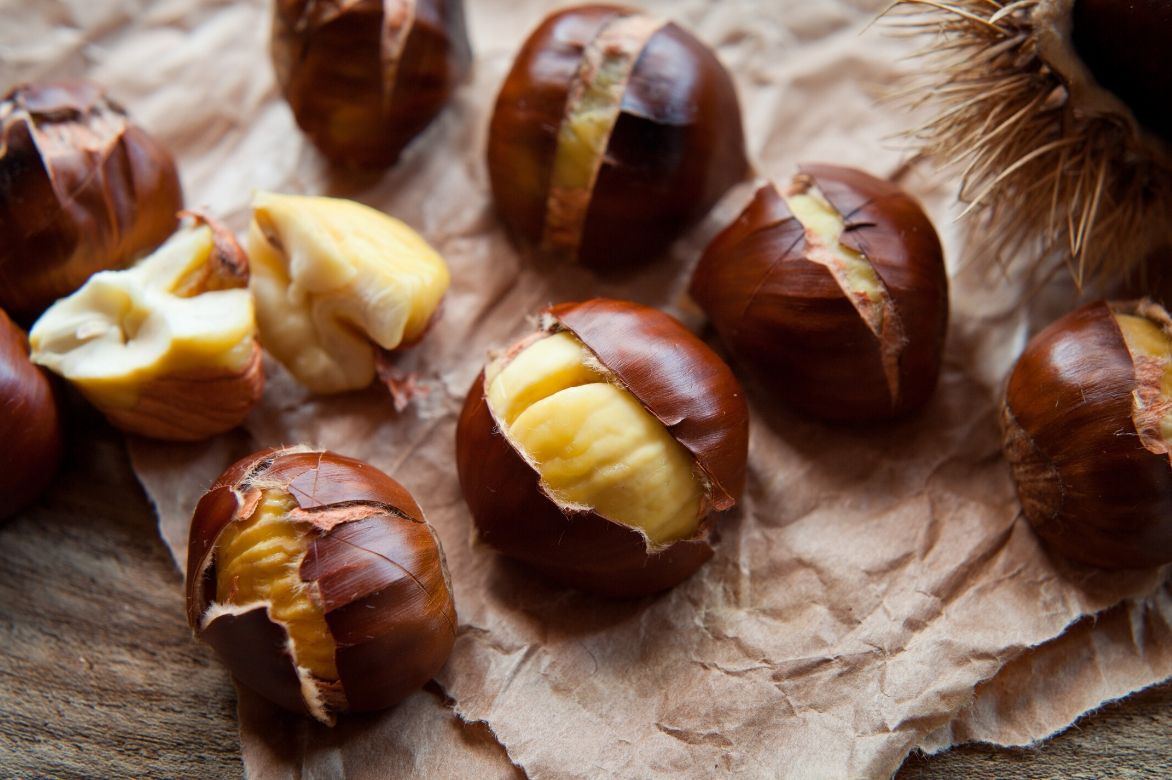
Multiplication
Layering by burying a branch is the simplest method used by amateur gardeners. It is also possible to proceed with a graft (crown grafting or other methods) onto sessile oak when soil is calcareous or onto a rootstock resistant to ink disease (beware of compatibility problems between rootstock and scion). The sowing remains a simple way to multiply wild chestnut, though expect to wait 20–25 years before obtaining chestnuts.
Layering of chestnut
- Place a portion of flexible branch from parent plant in contact with soil, leaving its tip exposed,
- Drive a metal peg to hold it firmly in soil,
- Separate the layer after about one year.
Layering in coppice shoots is widely practised in chestnut groves but it requires cutting back trunk of tree to 20 cm above soil, burying base of young shoots as soon as they reach 20 cm then separating young layers.
Sowing chestnuts
- Bury chestnuts in autumn in a nursery bed a few centimetres deep.
- Prick out seedlings in spring without breaking radicle, into a deep pot or to their final position.
Uses and companion planting
Chestnut can be used as a shade tree, as a single specimen or in a small group, mixed or not with other essential oils such as oaks or maples. Allow at least 10 m between tree and house. You can also plant it in a rural hedgerow where it will attract many pollinating insects in June–July and provide food for wildlife.

Find out more
- Discover our range of chestnut trees, and to help you choose, read Gwenaëlle’s advice: How to choose a chestnut tree?
- Learn more about harvest and storage of chestnuts
- Discover our advice sheet: Chestnut and marron, what are the differences?
- Subscribe!
- Contents


































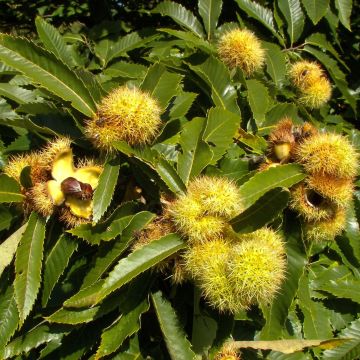
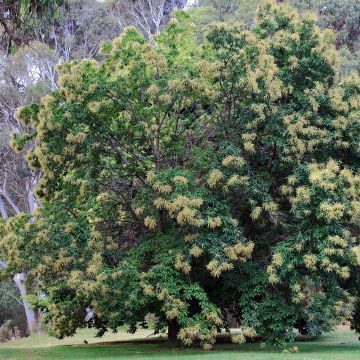

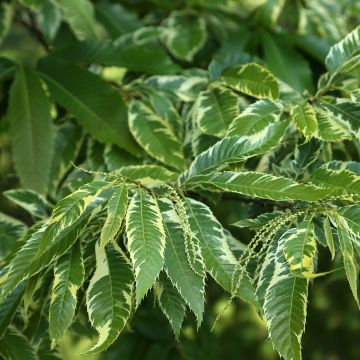
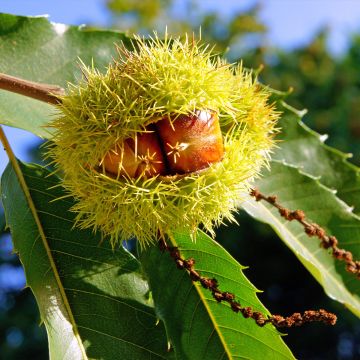
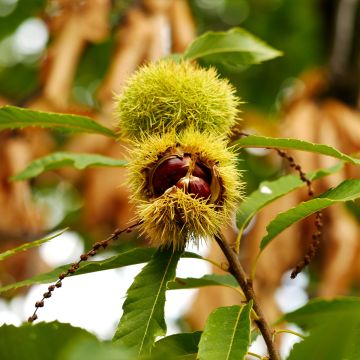
Comments